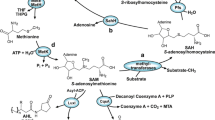Abstract
The direct selection of bacteriocin-producing lactic fermentation bacteria was possible by plating diluted cultures of Pediococcus acidilactici on mixed agarose agar layers with the amount of each component incrementally adjusted to 1.2% (w/v). Between 0.5 and 1% agarose, the increased flexibility of the solidified support layer allowed its removal from Petri dishes without tearing and its smooth layering on the surface of 1.5% (w/v) standard agar medium seeded with Listeria innocua as the test organism. Selection of bacteriocin-producing clones was based on the size of inhibition zones visible in the bottom agar layer under colonies growing on the agarose/agar top layer. The lack of contact with the test organism permitted the transfer of superior clones from the surface of the agarose/agar layer directly into an appropriate nutrient medium.
Similar content being viewed by others
References
Barefoot SF, Klaenhammer TR (1983) Detection and activity of lactacin B, a bacteriocin produced by Lactobacillus acidophilus. Appl. Environ. Microbiol. 45: 1808-1815.
Bhunia AK, Johnson MC, Ray B (1988) Purification, characterization and antimicrobial spectrum of a bacteriocin produced by Pediococcus acidilactici. J. Appl. Bacteriol. 65: 261-268.
Brown LR (1982) Antibiotic testing vessel. United States Patent No. 4,326,028.
Castellano P, Farias ME, Holzapfel W, Vignolo G (2001) Sensitivity variations of Listeria strains to the bacteriocins, lactocin 705, enterocin CRL35 and nisin. Biotechnol. Lett. 23: 605-608.
Coderre PE, Somkuti GA (1999) Cloning and expression of the pediocin operon in Streptococcus thermophilus and other lactic fermentation bacteria. Curr. Microbiol. 39: 295-301.
Colwell FS, Speidel HK (1985) Diffusion through a double-sided plate: development of a method to study alga-bacterium interactions. Appl. Environ. Microbiol. 50: 1357-1360.
Federal Register (1988) Nisin preparation: affirmation of GRAS status as a direct human food ingredient. Fed. Reg. 54: 11247-11251.
Guerra NP, Pastrana L (2001) Enhanced nisin and pediocin production on whey supplemented with different nitrogen sources. Biotechnol. Lett. 23: 609-612.
Gupta RK, Batish VK (1992) Genetic evidence for plasmid-encoded lactococcin production in Lactococcus lactis subsp. lactis 484. Curr. Microbiol. 24: 231-238.
Harding C, Shaw BG (1990) Antimicrobial activity of Leuconostoc gelidum against closely related species and Listeria monocytogenes. J. Appl. Bacteriol. 69: 648-658.
Holzapfel WH, Geisen R, Schillinger U (1995) Biological preservation of foods with reference to protective cultures, bacteriocins and food-grade enzymes. Int. J. Food Microbiol. 24: 343-362.
Jack RW, Tagg JR, Ray B (1995) Bacteriocins of Gram-positive bacteria. Microbiol. Rev. 59: 171-200.
Joerger MC, Klaenhammer TR (1990) Cloning, expression and nucleotide sequence of the Lactobacillus helveticus 481 gene encoding the bacteriocin helveticin J. J. Bacteriol. 172: 6339-6347.
Kekessy DA, Piguet JD (1970) New method for detecting bacteriocin production. Appl. Microbiol. 20: 282-283.
Lewus CB, Montville TJ (1991) Detection of bacteriocins produced by lactic acid bacteria. J. Microbiol. Meth. 13: 145-150.
Molitor E, Sahl HG (1991) Applications of nisin: a literature survey. In: Jung G, Sahl HG, eds. Nisin and Novel Lantobiotics. Leiden, The Netherlands: Escom Publishers, pp. 434-439.
Morgan SM, Galvin M, Kelly J, Ross RP, Hill C (1999) Development of lacticin 3147-enriched whey powder with inhibitory activity against foodborne pathogens. J. Food Prot. 62: 1011-1016.
Mugochi, T, Nandakumar MP, Zvauya R, Mattiasson B (2001) Bioassay for the rapid detection of bacteriocins in fermentation broth. Biotechnol. Lett. 23: 1243-1247.
Oscariz JC, Lasa I, Pisabarro G (1999) Detection and characterization of cerein 7, a new bacteriocin produced by Bacillus cereus with a broad spectrum of activity. FEMS Microbiol. Lett. 178: 337-341.
Parente E, Brienza C, Moles M, Ricciardi A (1995) A comparison of methods for the measurement of bacteriocin activity. J. Microbiol. Meth. 22: 95-108.
Pilet MF, Dousset X, Barre R, Novel G, Desmazeaud M, Piard JC (1995) Evidence of two bacteriocins produced by Carnobacterium piscicola and Carnobacterium divergens isolated from fish and active against Listeria monocytogenes. J. Food Prot. 58: 256-262.
Pucci MJ, Vedamuthu ER, Kunka BS, Vanderbergh PA (1988) Inhibition of Listeria monocytogenes by using bacteriocin PA-1 produced by Pediococcus acidilactici PAC 1.0. Appl. Environ. Microbiol. 54: 2349-2353.
Ray SK, Johnson MC, Ray B (1989) Bacteriocin plasmids of Pediococcus acidilactici. J. Ind. Microbiol. 4: 163-171.
Ross PR, Galvin M, McAuliffe O, Morgan SM, Ryan MP, Twomey DP, Meaney WJ, Hill C (1999) Developing applications for lactococcal bacteriocins. Antonie van Leeuwenhoek 76: 337-346.
Stiles ME (1996) Biopreservation by lactic acid bacteria. Antonie van Leeuwenhoek 70: 331-345.
Tagg JR, McGiven AR (1971) Assay system for bacteriocins. Appl. Microbiol. 21: 943.
Author information
Authors and Affiliations
Rights and permissions
About this article
Cite this article
Somkuti, G., Steinberg, D. Agarose/agar assay system for the selection of bacteriocin-producing lactic fermentation bacteria. Biotechnology Letters 24, 303–308 (2002). https://doi.org/10.1023/A:1014089304918
Issue Date:
DOI: https://doi.org/10.1023/A:1014089304918




